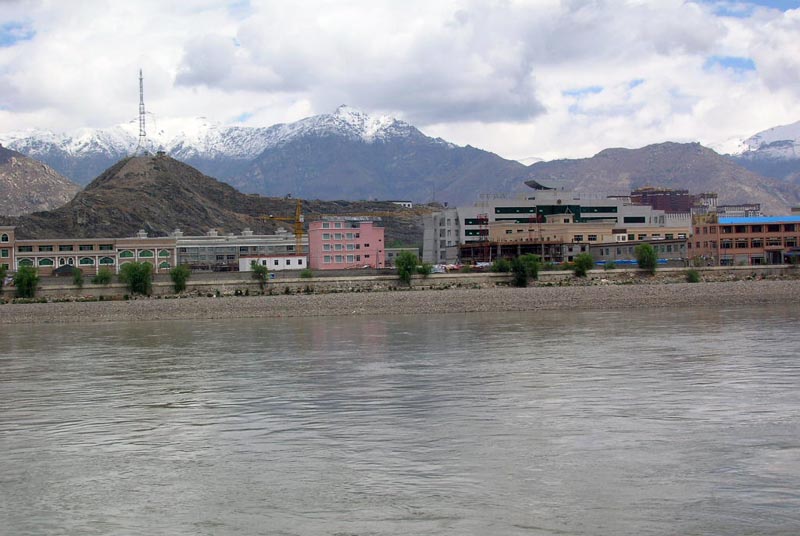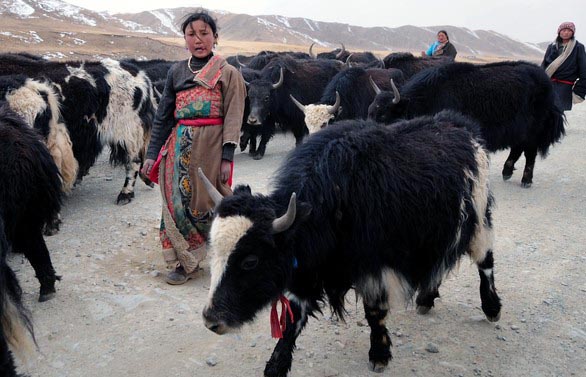Dharamshala: Chinese government claims to have "settled nearly 50,000 Tibetan nomads into sedentary communities in a drive to protect the remote alpine region's fragile ecology from their herds." Under the façade of environmental protection, this act will have a disastrous impact on the Tibetan herders’ ability to maintain their traditional lifestyles and will threaten a distinctive form of Tibetan cultural identity.
 Dharamshala: Chinese government claims to have "settled nearly 50,000 Tibetan nomads into sedentary communities in a drive to protect the remote alpine region's fragile ecology from their herds." Under the façade of environmental protection, this act will have a disastrous impact on the Tibetan herders’ ability to maintain their traditional lifestyles and will threaten a distinctive form of Tibetan cultural identity.
Dharamshala: Chinese government claims to have "settled nearly 50,000 Tibetan nomads into sedentary communities in a drive to protect the remote alpine region's fragile ecology from their herds." Under the façade of environmental protection, this act will have a disastrous impact on the Tibetan herders’ ability to maintain their traditional lifestyles and will threaten a distinctive form of Tibetan cultural identity. According to the Chinese state-run Xinhua news agency, 49,631 Tibetans from nomadic families have been settled over the past four years—under a policy that Tibetan activists decry as a devastating Chinese blow to the Buddhist region's ancient culture. The report stated that the nomads have been relocated away from their traditional homeland, a rugged region on the Tibetan plateau that contains the headwaters of three Asia's three major rivers: the Yellow, Yangtze, and Mekong.
In addition to eradicating the nomads’ lifestyle, an ancient Tibetan tradition, this policy also threatens potential ruin for the Tibetan Plateau, and consequently for billions of people living in the Indian sub-continent. As mentioned above, Tibet houses the sources of Asia's major rivers, and scientists state that if Chinese-sponsored open mining continues to increase in this region, disastrous effects could be felt across the subcontinent.
The report claims that the resettlement policy aims at to protect the ecology of the area from overgrazing by the nomads' herds. But in fact, it is surprising that the herders’ unique and highly evolved culture of nomadic pastoralism has survived at all since China’s invasion in 1950. Since then, the nomads’ sustainable culture has been ravaged by a series of disastrous policies issued by Beijing-based bureaucrats who have no knowledge and understanding of the realities of living on the remote Tibetan Plateau. Their directives have been driven by prevailing political priorities rather than the specialized needs of the nomads and the Tibetan Plateau ecosystem.
 Collectivization and new herding practices imposed by the communist regime led to famine and over-grazed grasslands. The policies imposed on the recently established collectivizes during the 1950s and 60s demanded widespread cultivation of wheat, rather than the traditional barley. Tibet’s climate is too cold for wheat to thrive, and intensive cultivation of this inappropriate crop exhausted the soil, resulting in ecological damage, widespread degradation of the grasslands, and intermittent famine throughout the 1950s, 60s and 70s.
Collectivization and new herding practices imposed by the communist regime led to famine and over-grazed grasslands. The policies imposed on the recently established collectivizes during the 1950s and 60s demanded widespread cultivation of wheat, rather than the traditional barley. Tibet’s climate is too cold for wheat to thrive, and intensive cultivation of this inappropriate crop exhausted the soil, resulting in ecological damage, widespread degradation of the grasslands, and intermittent famine throughout the 1950s, 60s and 70s.
Chinese scientists say that Tibet's glaciers are melting rapidly, and warn this could cause widespread future flooding in downstream regions. They also suggest that the disappearance of the glaciers will threaten water supplies across Asia.
However, Tibetans insist that said the Chinese relocation policy destroys the environmentally sustainable pastoral culture of Tibetan cattle and sheep herders. For more than 4000 years, nomads have grazed herds of yaks and mountain sheep across the vast grasslands of Tibet. The herds are intrinsically connected with both the identity of the nomads and their survival in the harsh, high-altitude environment of the Tibetan Plateau: the animals provide not only meat and milk, but their skins are dried and used to insulate traditional tents. Dung is also dried and used to heat the tents and provide fuel for cooking. Wool and fur from the animals are used as clothing by the nomads.
Xinhua quoted a local government official as saying that they have offered the nomads vocational training and set up a fund to encourage them to start their own businesses, while building new schools and other facilities, Chinese officials said in 2007 that the government was eventually planning to resettle 100,000 Tibetan nomads.


![Tibet has a rich history as a sovereign nation until the 1950s when it was invaded by China. [Photo: File]](/images/stories/Pics-2024/March/Tibet-Nation-1940s.jpg#joomlaImage://local-images/stories/Pics-2024/March/Tibet-Nation-1940s.jpg?width=1489&height=878)















